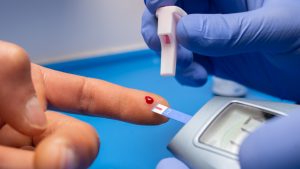Imagine a future where type 2 diabetes is not a threat to your health and well-being. A future where you have complete control over your health and can enjoy a fulfilling and active life. That future can be your reality thanks to early detection of prediabetes!
In this informative and hopeful blog, we will guide you on a journey towards preventing type 2 diabetes. We will explore prediabetes in depth, its signs and risk factors, and provide you with the tools and strategies you need to adopt a lifestyle that promotes your overall health and propels you towards a brighter future.
What is prediabetes and why is it important to detect it early?
Prediabetes is defined as a condition in which blood sugar (glucose) levels are higher than normal, but not high enough to be diagnosed with type 2 diabetes. While it may not present with noticeable symptoms, prediabetes is a precursor to type 2 diabetes, a chronic disease that can lead to serious health complications.
Early detection of prediabetes is crucial to prevent or significantly delay progression to type 2 diabetes. By taking timely action, you can adopt lifestyle changes that will help you normalize your blood sugar levels and dramatically reduce your risk of developing this disease.
What are the signs and risk factors of prediabetes?
While prediabetes can go unnoticed, there are some indicators that can alert you to its presence:
- Increased thirst and urination
- Excessive hunger
- Unexplained fatigue
- Blurred vision
- Numbness or tingling in the hands or feet
In addition to these signs, certain risk factors increase the likelihood of developing prediabetes:
- Overweight or obesity
- Family history of diabetes
- Older age (45 years or older)
- Physical inactivity
- History of gestational diabetes
- High blood pressure
- High cholesterol
How can I detect prediabetes?
Detecting prediabetes is a simple and accessible process. Your doctor may recommend blood sugar tests, such as a fasting blood sugar test or an oral glucose tolerance test, if you have risk factors or experience any of the signs mentioned above.
What can I do if I have prediabetes?
Don’t worry! Prediabetes is not a sentence for type 2 diabetes. On the contrary, it represents an opportunity to take control of your health and prevent the development of a chronic disease.
With lifestyle changes, you can reverse prediabetes or prevent it from progressing to type 2 diabetes. These changes include:
1. Adopt a healthy diet:
- Choose foods that are rich in nutrients and low in calories, saturated fat, and added sugars.
- Prioritize fruits, vegetables, whole grains, legumes, and lean proteins.
- Limit your intake of red and processed meats, foods high in saturated and trans fats.
- Reduce your consumption of added sugars found in sugary drinks, sweets, and desserts.
- Opt for healthier sweeteners like fresh fruits or stevia.
2. Increase physical activity:
- Engage in at least 30 minutes of moderate-intensity physical activity most days of the week.
- You can start with activities like brisk walking, swimming, or cycling.
- Find activities you enjoy and that you can incorporate into your daily routine.
- Even small changes, like taking the stairs instead of the elevator or taking active breaks during work, can make a big difference.
3. Achieve and maintain a healthy weight:
- If you are overweight or obese, even a small amount of weight loss can have a significant impact on your risk of diabetes.
- Consult with your doctor or a registered dietitian to establish a personalized and safe weight loss plan.
- Remember that the goal is not just to lose weight, but to adopt a healthy and sustainable lifestyle.
4. Quit smoking:
- Smoking significantly increases your risk of diabetes.
- If you smoke, quitting is one of the best decisions you can make for your health.
- There are various resources and programs available to help you quit smoking successfully.
5. Manage stress:
- Chronic stress can affect blood sugar levels.
- Find healthy ways to manage stress, such as yoga, meditation, or spending time in nature.
- Prioritize adequate sleep, as it plays a crucial role in stress management and overall health.
6. Schedule regular checkups with your doctor:
- Regular medical checkups are essential for monitoring your prediabetes and overall health.
- Your doctor can provide personalized guidance and support to help you manage your prediabetes and reduce your risk of developing type 2 diabetes.
Remember:
- Early detection of prediabetes is key to preventing type 2 diabetes.
- With lifestyle changes, you can reverse prediabetes or prevent its progression.
- Adopting a healthy lifestyle is an investment in your future!
E4 Helps you:
At E4, we’re dedicated to revolutionizing how people manage type 2 diabetes through our innovative E4 Alive program. Our team of specialists has joined forces to create a comprehensive solution aimed at empowering individuals to take charge of their health journey. With personalized support and resources tailored to each person’s unique needs, we make managing diabetes simpler and more effective than ever before.
E4 Alive offers a range of tools and resources to help you better understand and control your blood sugar levels. Our program provides personalized guidance to create a healthy eating plan and integrate regular physical activity into your daily routine. Plus, you’ll have access to a supportive community of individuals who understand your challenges and are there to offer encouragement and guidance every step of the way.
By joining E4 Alive, you can effectively manage your blood glucose levels, improve long-term glycemic control, reduce your risk of diabetes-related complications, and enhance your overall quality of life. It’s not just a program; it’s an opportunity to reclaim your health and vitality. Ready to start your journey to better health? Visit THIS PAGE to learn more about E4 Diabetes Solutions and the E4 Alive program.
To learn more about E4 Diabetes Solutions and the E4 Alive program, visit THIS PAGE.

Type 2 Diabetes: Is It Really Reversible?
A recent National Geographic article [link] explores how type 2 diabetes could be reversible with the right approaches. This condition, which affects millions of people worldwide, has long been considered a chronic and progressive disease. However, recent research challenges this perception and suggests that with lifestyle changes and the right approach, remission is possible. The

How Do GLP-1 Drugs Compare? A Breakdown of Ozempic, Mounjaro, and Trulicity
GLP-1 receptor agonists have revolutionized diabetes management, with drugs like Ozempic, Mounjaro, and Trulicity leading the market. But how do these medications compare in terms of effectiveness, side effects, and patient outcomes? Let’s explore their differences and what they mean for diabetes patients. Understanding GLP-1 Medications GLP-1 receptor agonists mimic a natural hormone that helps

Why Has Medicare Spending on Diabetes Medications Skyrocketed in 5 Years?
In the past five years, Medicare spending on diabetes medications has increased nearly fivefold, reaching $35.8 billion in 2023. This surge has been primarily driven by the growing use of GLP-1 drugs such as Ozempic, Mounjaro, and Trulicity. But what is behind this cost escalation, and how does it affect patients and the U.S. healthcare

The Gut Microbiota and Blood Sugar Control: A Hidden Connection
The human gut is home to trillions of bacteria that play a crucial role in digestion, immune function, and even metabolism. Recent research has revealed a fascinating link between the gut microbiota and blood sugar regulation, shedding light on how the balance of microbes in our intestines can influence diabetes risk and overall metabolic health.

The Dawn Phenomenon: Why Blood Sugar Rises While You Sleep
For many people with diabetes, waking up with high blood sugar levels can be frustrating—especially if they didn’t eat anything overnight. This early-morning spike in blood glucose is known as the Dawn Phenomenon, and it happens due to natural hormonal changes in the body. But why does it occur, and how can it be managed?

The Influence of Red Light on Blood: Can It Improve Diabetes?
Type 2 diabetes is a metabolic disease characterized by insulin resistance and elevated blood glucose levels. In the search for complementary alternatives to improve glycemic control, red light therapy has gained attention due to its potential to enhance circulation, reduce inflammation, and optimize cellular function. But what does science say about it? ✨ What is

